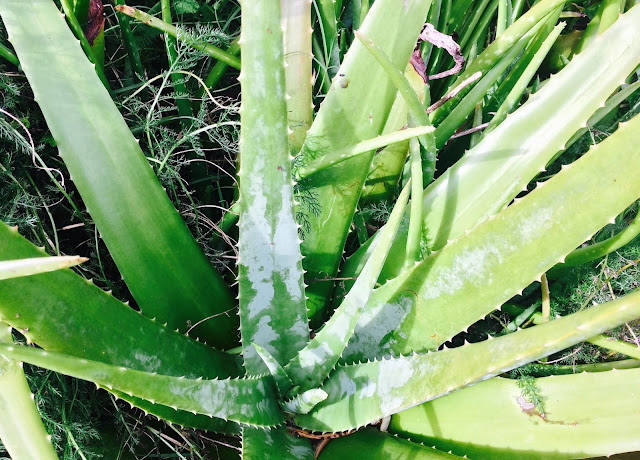Aloe vera is a particularly easy plant to grow – an essential I think in just about every garden. It is cultivated around the world and has been used extensively as a traditional medicine. It has many uses like hair conditioner, face moisturiser, itch and bite soother, digestion aid.. to mention a few.
Many a verandah and window sill have a pot of Aloe vera growing and it is widely grown commercially for the use in skincare products.
It is well known as a sunburn plant – offering cooling relief, but it has so many valuable uses in the home that help me replace commercial packaged products.
In the video below I talked about how I grow, harvest, use and share my aloe. Do you have some growing? How do you use it? Perhaps you have a great recipe for homemade hand sanitiser with aloe?
 |
| Mature Aloe vera in my garden (with Yarrow growing around) – the larger leaves are dark green and full of gel. |
 |
| Attractive and tall flower stems of my Aloe vera |
What is Aloe vera good for?
- leave in hair conditioner – simply rub the gel in your hair and comb through. This does not need to be washed out. When I do this, my hair feels softer.
- face moisturiser – gently rub the gel into the skin. It feels great.
- after-shave moisturiser – I use on my legs to prevent dry skin after shaving.
- elbow and knee moisturiser – it really helps to prevent and heal dry skin
- insect itch relief – its cooling feel on the skin helps to soothe a whole range of insect bites
- burn relief – I open a leaf and strap it on with a bandage for immediate relief. I leave it on for hours and find that blisters don’t form and it prevents scarring.
- healthy digestion – adding some clear gel to homemade juices keeps the digestion system healthy
 |
| Aloe vera in my garden amongst the Pineapple Sage and under the Lemon Myrtle |
In my permaculture garden, the things I use a lot are placed close like Aloe vera but also Lemon Myrtle and Kaffir Lime and of course herbs like Basil, Coriander, Thyme and Rosemary, and my salad greens.
Which bit of Aloe Vera to use?
I use just the gel inside the Aloe vera leaf – it is clear and odourless. I don’t use the green outer of the leaf or the yellow latex (aloin) that oozes when just cut. It can be irritating to the skin, and there have been concerns about whether it is safe to use. If you are buying Aloe vera juice – make sure it is just from the inner leaf gel. Consuming the whole leaf is no longer recommended.
How to harvest Aloe Vera Gel.
To harvest the Aloe vera gel …
- I cut off a leaf as close down to the base as possible.
- I stand it up and allow the yellow sap (latex) to drain for a few minutes. (This can be an irritant to some people’s skin and can be staining).
- I cut off a chunk (as much as I need) of the leaf and carefully slice out the clear gel.
- If I have leftover leaf, I keep this in the fridge for later use. My Aloe vera leaves are now thick and huge so it often takes me a few days to use a leaf.
Where to grow Aloe vera?
Aloe vera prefers warm climates and in really hot areas it actually needs shade to prevent it from drying out and getting sunburnt (dry red/brown tips). It can grow in cooler areas too but usually in pots so it can be moved to a sheltered position or indoors in winter.
Aloe vera can tolerate poor soil and survives neglect, but to get big fleshy leaves full of gel it does need some sun protection and water. This makes sense considering the leaves are over 95% water.
How to propagate Aloe vera.
 |
| (source: www.aloe1.com) |
Other names for Aloe vera
Aloe barbadensis, Aloe indica, Aloe perfoliata var. vera, Chinese Aloe, Indian Aloe, True Aloe, Barbados Aloe, Burn Aloe, First Aid Plant

